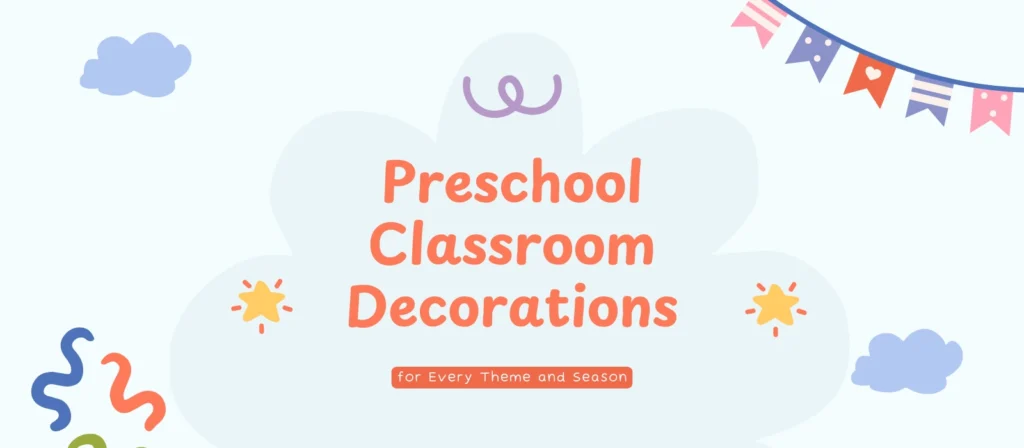Are your preschool walls feeling dull and lifeless? Do you struggle to find classroom decoration ideas that are both engaging for children and easy for teachers to manage? Are seasonal and themed decor projects becoming overwhelming for your staff and budget? If these questions sound familiar, you’re not alone. Many preschool owners and directors face the exact same frustrations.
Preschool classroom decorations aren’t just about making a space look cute. They’re essential tools that shape how children learn, behave, and feel every day. A well-decorated preschool classroom can boost mood, improve focus, encourage interaction, and even reinforce curriculum goals. In short, the way you decorate is an investment in your students’ success.
And here’s the good news: creating inspiring preschool classroom decorations doesn’t have to be difficult or expensive. In this guide, I’ll walk you through everything—from seasonal themes to safety compliance to DIY options—so you can transform any preschool space into a dynamic, educational environment that children (and teachers) love coming back to every day.
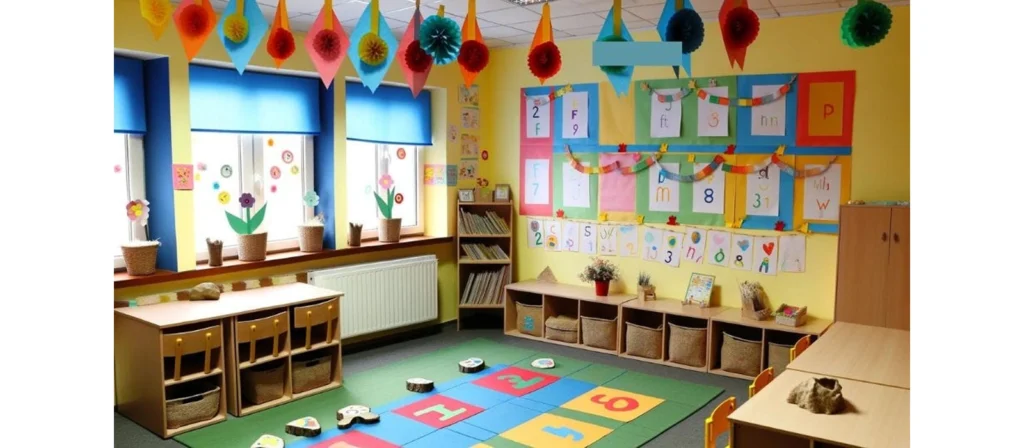
Why Are Preschool Classroom Decorations So Important?
When people walk into a preschool classroom, the first thing they often notice isn’t the toys or the furniture—it’s the atmosphere. And that atmosphere is crafted largely through thoughtful, intentional preschool classroom decorations. These aren’t just visual elements. They’re educational tools, behavioral guides, and emotional regulators all rolled into one.
Young children learn through play and exploration, and the environment acts as the third teacher. Studies show that children in visually stimulating yet orderly environments demonstrate better attention spans and greater interest in learning tasks source. Bright, engaging spaces encourage positive behavior, creativity, and social development.
Effective classroom decor for preschool isn’t just thematic—it’s functional. For example, wall posters that reinforce the alphabet, numbers, or colors serve as passive learning tools. Zones defined with thematic decor help children transition between activities more smoothly. A reading nook decorated with calm colors and cozy textures sends a message: “This is a safe, relaxing place to enjoy books.”
Moreover, classroom decorations preschool designs are essential for emotional comfort. Friendly visuals, like smiley animals or nature scenes, help ease anxiety, especially in younger children just starting their educational journey. They make the space feel more like home.
From a psychological perspective, decorations help children make sense of the world. Preschool classroom decoration themes like seasons, weather, or holidays offer a tangible connection to time, culture, and community. A Thanksgiving-themed wall or a spring flower garden bulletin board fosters a shared sense of identity among classmates.
And finally, preschool classroom decorations also serve a communication role. They visually convey the values of your school to parents, visitors, and staff. A well-decorated room says: “We care about quality, we’re organized, and we prioritize children’s development.”
So whether it’s preschool classroom wall decorations, classroom door decoration ideas for preschool, or even ceiling decor, each element contributes to an ecosystem where children feel secure, inspired, and ready to learn.
Key Elements of Preschool Classroom Decorations
Designing the perfect preschool classroom decorations means more than taping a few posters to the wall. It’s a deliberate process of curating visual, functional, and emotional elements that guide children’s behavior, foster learning, and reflect the school’s values. Here are the key elements you need to master:
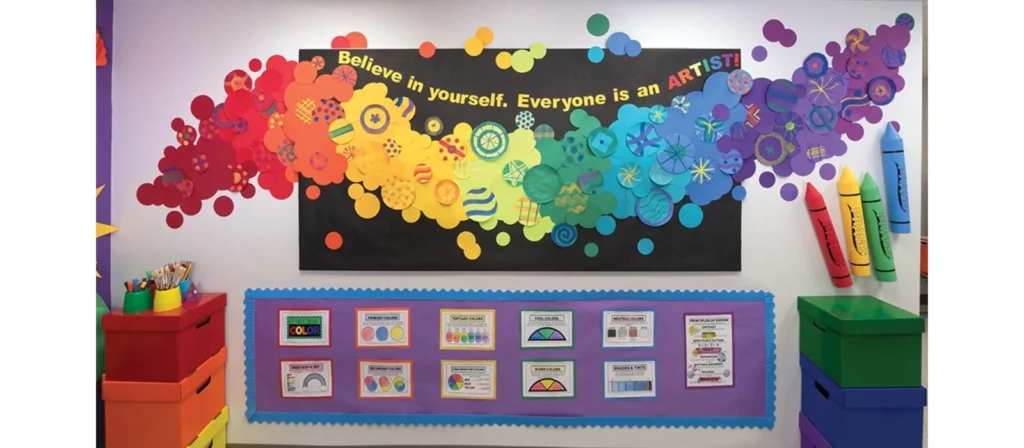
1. Color Psychology and Emotional Tone
Colors play a vital role in setting the classroom’s mood. Soft blues and greens foster calm, while yellows stimulate creativity. Too many bold colors in one place can cause overstimulation. Choose a base palette that reflects the theme and vary accent colors by season. For example, fall decorations for preschool classroom might use warm oranges and browns, while winter preschool classroom decorations lean into icy blues and silvers.
2. Defined Zones Using Thematic Decor
Children feel safer and more focused when spaces are clearly defined. Use rugs, wall decals, or ceiling hangings to distinguish between play zones, reading corners, and craft areas. Preschool classroom theme decor reinforces these zones—like jungle-themed play corners or boho preschool classroom decor for sensory nooks.
3. Interactive and Educational Decor
Your decorations should do more than decorate—they should teach. Letter trees, number trains, calendar charts, and weather boards are great examples of integrating learning into your design. Free printable preschool classroom decorations can offer seasonal refreshes while keeping costs low.
4. Seasonal and Holiday Integration
Preschool classroom decorations should evolve with the calendar. Fall leaves, Halloween pumpkins, Thanksgiving turkeys, Christmas trees—these elements provide rhythm to the year. Preschool christmas classroom decorations and preschool halloween classroom decorations aren’t just festive—they build cultural awareness and excitement.
5. Material Safety and Maintenance
Always choose non-toxic, flame-retardant, easy-to-clean materials. Children will touch, pull, and explore everything. Wall art should be laminated, ceiling decorations for classroom securely anchored, and classroom door decoration ideas for preschool should not obstruct visibility or egress.
6. Flexibility and Storage
Use Velcro, magnetic strips, and removable hooks so decorations can be swapped easily. Create a labeled storage system to manage seasonal classroom decorations preschool style. Having a preschool classroom decor bundle for each season helps streamline rotation.
7. Inclusion and Representation
Incorporate decorations that reflect the cultural backgrounds and abilities of your children. Representation fosters belonging. Christian preschool classroom decorations may be appropriate in some institutions, while others may choose multicultural posters or universal symbols of peace and kindness.
When all these elements are intentionally chosen and well-integrated, your preschool classroom decorations become more than pretty visuals—they transform into tools that drive developmental outcomes, classroom harmony, and educational excellence.
Theme-Based Preschool Classroom Decoration Ideas
When it comes to preschool classroom decorations, themes are your best friend. They help organize your space visually and educationally while engaging children in exciting, age-appropriate narratives. A strong theme boosts learning, simplifies transitions, and even helps children build connections between their daily experiences and broader concepts like seasons, holidays, or values.
1. Seasonal Themes That Bring Classrooms to Life
Children learn to understand time and nature through the changing seasons. Decorating preschool classrooms to reflect spring, summer, fall, and winter introduces them to cycles, weather, colors, and traditions.
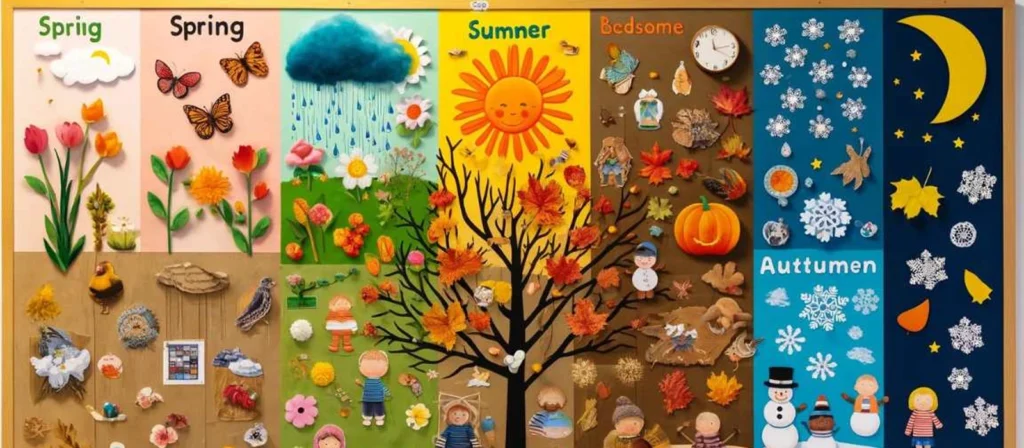
- Spring Preschool Classroom Decorations: Think flowers, bees, butterflies, and bright pastels. Perfect for renewing bulletin boards and art corners.
- Summer Preschool Classroom Decorations: Use ocean themes, sunshine motifs, and popsicles to bring joy and brightness.
- Fall Preschool Classroom Decorations: Highlight pumpkins, leaves, acorns, and orange hues. Don’t forget fall classroom door decoration ideas for preschool.
- Winter Preschool Classroom Decorations: Snowflakes, snowmen, pine trees, and twinkling lights. Great for cozying up reading areas and celebrating the season.
2. Holiday-Themed Decor to Celebrate Traditions
Children love festive environments, and holiday decorations can be used to spark curiosity and conversation. Whether it’s Halloween or Valentine’s Day, themed preschool classroom decor can offer fun learning moments.
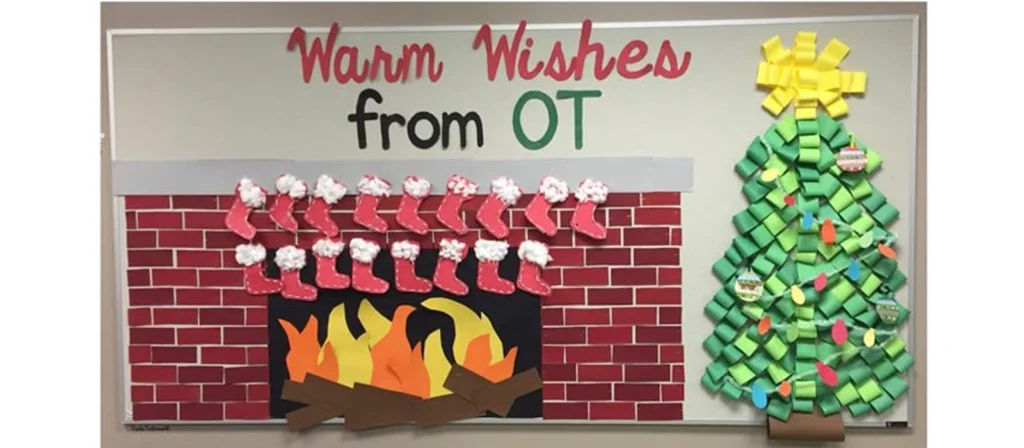
- Preschool Halloween Classroom Decorations: Ghosts, pumpkins, and friendly monsters—great for art projects and role play.
- Preschool Christmas Classroom Decorations: Trees, ornaments, reindeer, and cozy fireplaces turn the class into a wonderland. Use preschool classroom christmas decorating ideas to build excitement.
- Valentines Decorations for Preschool Classroom: Hearts, love notes, and friendship-themed displays that encourage emotional expression.
- Spring Festivals & Easter Themes: Bunny tracks, pastel eggs, and baby animals.
3. Pop Culture & Storybook Characters
Kids relate strongly to characters. Incorporating beloved figures makes the classroom instantly inviting.
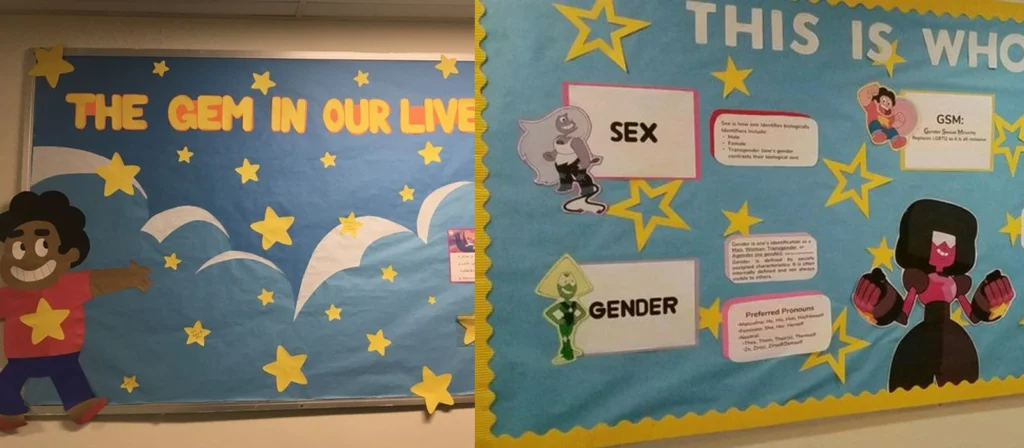
- Steven Universe Themed Classroom Ideas: Take inspiration from the vibrant, emotional, and inclusive world of Steven Universe to create a classroom that celebrates individuality and kindness. Use character cutouts like Steven, Garnet, Pearl, and Amethyst to decorate walls and windows. Incorporate symbols such as gem shapes, stars, and the Crystal Temple across bulletin boards and door decor. Display quotes about friendship, empathy, and bravery in reading areas or circle time spaces—these reinforce emotional intelligence. Use a color palette of soft pinks, purples, and cosmic blues to echo the show’s universe. This theme is especially appealing for its ability to support social-emotional learning in a playful and recognizable way for fans of the show.
- Other Characters: Animals, dinosaurs, superheroes, fairy tales. These themes support story-based teaching and imaginative play.
4. Value-Based and Cultural Themes
Preschool classroom decoration themes can reflect more than aesthetics—they can express values and identity.
- Christian Preschool Classroom Decorations: Bible verses, peaceful doves, nativity scenes, and fruit of the spirit visuals.
- Multicultural Themes: Globes, flags, international greetings, and celebrations like Lunar New Year or Diwali.
- Nature and Sustainability: Incorporate natural materials, recycled crafts, and green themes. These are central to natural classroom decorations and boho preschool classroom decor.
5. Creative DIY and Pinterest-Inspired Decor
Platforms like Pinterest are treasure troves of ideas. From preschool classroom decoration images to step-by-step guides, you can find:
- DIY paper flower walls, felt board stations, craft stick puppets.
- Printable classroom decorations for preschool for each theme.
- Hanging ceiling decorations for classroom with lightweight, recycled materials.
Themes provide a consistent framework and visual identity for your learning environment. Whether you’re changing themes monthly or tying them to your curriculum, a thoughtful approach ensures your preschool classroom decorations serve both aesthetic and pedagogical purposes.
Classroom Decoration by Area: Wall, Door, Ceiling
Every square foot of a preschool classroom has the potential to inspire, engage, and educate. When designing preschool classroom decorations, it’s crucial to treat each surface—walls, doors, ceilings—not just as a background, but as an active element of the learning environment. Here’s how to strategically decorate each of these key areas for maximum impact.
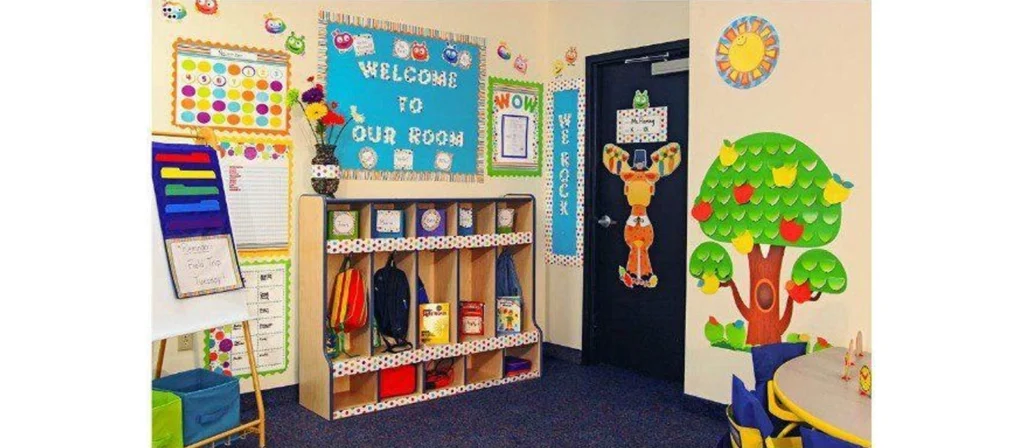
Wall Decor: Functional and Beautiful
The walls are prime real estate for thematic learning, routines, and visual storytelling. Focus on balance—don’t overload, but don’t leave them bare either.
- Preschool Classroom Wall Decorations: Alphabet borders, number lines, color charts, weather stations, and emotional expression posters. These decorations reinforce key learning concepts.
- Use bulletin boards for seasonal or monthly themes. For example, rotate between winter classroom wall decoration for preschool and spring flower collages.
- Add visual schedules and circle time boards near activity areas.
- Incorporate interactive elements like Velcro charts and magnetic shapes for active learning.
Door Decor: Welcoming and Thematic
Your classroom door is the first impression for children, parents, and teachers. Make it count.
- Classroom Door Decoration Ideas for Preschool: Start the year with a “Meet the Stars” door featuring student names. Use seasonal door makeovers like pumpkins in fall or snowflakes in winter.
- For holidays, try Christmas decorations for preschool classroom doors or a spring butterfly entrance.
- Highlight classroom values, such as kindness or friendship, using large cut-out words and student art.
- Always ensure decorations are fire-safe and do not obstruct visibility or escape routes.
Ceiling Decor: The Often-Ignored Canvas
Look up! Ceiling decorations are fantastic for adding whimsy and wonder to a space—especially for themes like outer space, rainforests, or holidays.
- Preschool Classroom Ceiling Decorations: Hang tissue paper pom-poms, string lights, handmade paper lanterns, or theme-related mobiles.
- Use transparent string to make paper stars, snowflakes, or seasonal items “float” above learning centers.
- Incorporate crafts made by the children—like spring kites, bees, or autumn leaves—to give them ownership over the space.
Well-planned classroom decoration by area allows for clear zones, efficient traffic flow, and immersive learning environments. Whether you’re decorating a reading nook wall, a festive door, or a dreamy ceiling, every detail helps shape a space where preschoolers thrive.
How to Decorate a Preschool Classroom on a Budget
You don’t need a big budget to make a big impact. In fact, some of the most creative and charming preschool classroom decorations come from resourceful planning and DIY spirit. Whether you’re furnishing a new space or updating a current one, these cost-effective strategies can help you decorate smartly without sacrificing style or function.
1. Plan Around Themes to Streamline Supplies
Choose a few recurring themes (seasons, holidays, values) and build reusable decor bundles. This helps you rotate decor without starting from scratch every month. A spring bundle, for example, could include artificial flowers, bee cutouts, and pastel backdrops that you use year after year.
2. Go Digital with Free Printables
There are hundreds of websites offering free printable preschool classroom decorations, including flashcards, alphabet borders, weather charts, and theme posters. Print in bulk, laminate for durability, and reuse for years. Check out resources like Teachers Pay Teachers, Twinkl, and Education.com.
3. Embrace DIY With Upcycled Materials
Use items you already have or can collect for free:
- Cardboard boxes become puppet theaters.
- Egg cartons turn into caterpillars.
- Bottle caps become counting tools.
- Fabric scraps become wall flags or bunting. This not only saves money but also teaches sustainability—a great value for preschoolers.
4. Involve Parents and Community
Invite parents to donate craft supplies, wrapping paper, or seasonal decorations they no longer use. Local stores or businesses may also be willing to donate materials if asked in advance.
5. Use Multi-Purpose Decor Items
Opt for flexible pieces: felt boards, magnetic displays, and chalkboard paint allow you to update visuals without replacing entire displays. Preschool classroom decor ideas should focus on function and reusability.
6. Rotate Rather Than Replace
Instead of buying new decor every season, rotate existing elements. Store items by theme in clearly labeled bins to make changing decor fast and organized. This approach also saves time for teachers.
7. Choose Affordable Materials Wisely
Look for foam sheets, colored paper, tissue paper, and string at dollar stores or wholesale craft suppliers. These go a long way in creating eye-catching designs for doors, ceilings, and bulletin boards.
Decorating preschool classroom spaces on a budget is about creativity, planning, and community effort. With a few reliable themes, DIY skills, and a network of support, you can build a beautiful, inspiring learning environment without overspending.
Safety and Educational Standards in Classroom Decorations
Preschool classroom decorations are more than aesthetics—they’re part of a learning environment that must meet safety and educational standards. Ignoring these can lead to safety hazards or ineffective learning spaces. Here’s how to ensure your decorations are compliant, safe, and developmentally appropriate.
1. Choose Safe and Non-Toxic Materials
Children touch everything. Materials used should be:
- Non-toxic and labeled safe for children.
- Flame-retardant (especially important for wall hangings and ceiling decor).
- Free from small detachable parts that could pose a choking hazard.
- Easy to clean and disinfect.
Certifications to look for include ASTM International safety standards, EN71 for toy safety (Europe), or CPSIA (Consumer Product Safety Improvement Act) compliance in the U.S. Ask suppliers to provide documentation when sourcing bulk decorations or materials.
2. Comply with Local Fire and Building Codes
Check with your local fire department or education authority on decoration regulations. Common rules include:
- Not covering more than 20-30% of classroom walls with flammable material.
- Avoiding obstructed exits or covered windows.
- Keeping ceiling hangings away from sprinklers or HVAC vents.
3. Developmentally Appropriate Visuals
Avoid overstimulation by limiting the number of competing visuals. Instead, choose:
- Soft, calm color palettes for quiet zones.
- Bold, high-contrast visuals for younger learners developing visual tracking.
- Large fonts and images children can easily recognize and interact with.
4. Reinforce Educational Objectives
Use decor to support what’s being taught:
- Alphabet walls, calendar boards, and number lines aid early literacy and numeracy.
- Visual behavior charts encourage self-regulation.
- Thematic decorations (e.g., weather, animals, holidays) support content learning.
5. Ensure Accessibility and Inclusion
- Avoid decorations that may alienate certain cultures, beliefs, or abilities.
- Display multicultural imagery and words in multiple languages.
- Install materials at children’s eye level to promote engagement.
Preschool classroom decorations must meet both emotional and functional goals. By ensuring all materials and design choices are safe, educational, and inclusive, you create a space that nurtures every child’s growth.
Preschool Classroom Decoration Mistakes to Avoid
Even with the best intentions, it’s easy to make common mistakes when designing preschool classroom decorations. Some of these can lead to overstimulation, safety hazards, or simply wasted time and money. Here’s what to avoid—and how to fix it.

1. Overcrowding the Environment
Too many visuals can overwhelm children and create sensory overload. It may even hinder their ability to focus. Stick to a cohesive color scheme and rotate decorations to avoid clutter.
2. Ignoring the Educational Purpose
Decor that’s only decorative and not instructional is a missed opportunity. Prioritize preschool classroom decorations that reinforce core learning concepts like literacy, numeracy, and social-emotional skills.
3. Choosing Style Over Safety
Never sacrifice safety for aesthetics. Avoid tacks, unsecured ceiling hangings, or anything that could fall or injure a child. Always opt for flame-retardant and non-toxic materials.
4. Using Inappropriate Themes
Themes that are too advanced, irrelevant, or culturally insensitive can create confusion or discomfort. Make sure every preschool classroom decoration theme is developmentally appropriate and inclusive.
5. Placing Everything at Adult Eye-Level
Children experience the classroom differently than adults. Position decor at child height where they can interact with it. Preschool classroom wall decorations should engage their perspective.
6. Failing to Involve the Kids
Classroom decorations become more meaningful when children participate in creating them. Include crafts, collaborative displays, and seasonal activities that let kids personalize their space.
7. Not Maintaining or Rotating Decor
Old, worn, or outdated decorations send a negative message. Create a schedule to refresh bulletin boards, door decor, and preschool classroom ceiling decorations seasonally or monthly.
Avoiding these common pitfalls ensures your preschool classroom decorations stay fresh, functional, and fun for both children and staff.
Managing Time and Logistics for Preschool Classroom Decorations Projects
Behind every successful preschool classroom decoration plan is a solid timeline and logistics strategy. Whether you’re running one classroom or managing several across a preschool chain, poor planning can lead to delays, budget overruns, or missed start dates. Here’s how to stay organized and on schedule.
1. Align Decor Planning with Academic Calendars
Start by reviewing your preschool’s annual academic calendar. Mark major holidays, seasons, and events like parent nights or open houses. This allows you to match your preschool classroom decorations to upcoming themes with proper lead time.
2. Create a Decoration Timeline
Build a month-by-month timeline for decoration themes. Include time for:
- Planning & material sourcing
- Production or printing
- Setup and installation
- Removal or storage
If your school starts in September, begin planning summer orders in May or June. This ensures ample time for delivery and assembly.
3. Account for Manufacturing and Shipping Time
When sourcing classroom decorations from overseas suppliers—like XIHA Furniture in China—keep in mind:
- Production lead time: 2–4 weeks depending on customization and order size
- Shipping time: 25–45 days by sea freight (10–15 days express air)
- Customs clearance: 3–7 days depending on destination country
Always buffer 1–2 weeks extra time to avoid issues. Rushing leads to costly express shipping or incomplete setups.
4. Consolidate Procurement and Logistics
Group furniture, decor, and accessories into single shipments. This reduces shipping costs and simplifies customs processes. XIHA can help you consolidate your preschool classroom decorations and furniture into one coordinated shipment.
5. Delegate Setup Responsibilities
Assign decoration zones (walls, doors, ceilings) to different staff or volunteers. Create a checklist and supervise the final installation. For larger orders, XIHA Furniture offers layout suggestions and implementation guidance to streamline the setup process.
6. Prepare for Seasonal Rotation
Store decorations in clearly labeled bins by season or theme. Rotate in new materials a few days before each seasonal change. This keeps your environment fresh and educational without unnecessary last-minute scrambling.
Time and logistics planning turn classroom decoration into a seamless, stress-free process. With the right tools and timeline, your preschool classroom decorations will always be ready—on theme, on time, and on budget.
Training Teachers to Maintain and Use Classroom Decorations Effectively
A beautiful preschool classroom filled with thoughtful decorations can only reach its full potential when teachers know how to use and maintain it. Preschool classroom decorations are not static—they’re dynamic tools for engagement and learning. That’s why training staff is just as important as selecting the right decor.
1. Include Teachers in the Design Process
Teachers understand their students’ needs best. Involve them in choosing themes, positioning items like preschool classroom wall decorations, or creating DIY elements. This builds ownership and ensures the space truly supports teaching goals.
2. Create an Orientation for New Decor
Whenever decorations are updated—seasonally or thematically—hold a brief orientation for staff. Walk through the new materials:
- Where and why each item is placed
- How to interact with interactive decor (e.g., Velcro charts, pocket boards)
- Safety guidelines for classroom ceiling decor or door signage
3. Assign Maintenance Roles
Assign teachers or aides specific decor responsibilities by area: one manages the bulletin board, another the door, another seasonal preschool classroom ceiling decorations. This ensures decor is refreshed regularly and maintained in good condition.
4. Use Decor as Daily Teaching Aids
Help teachers integrate classroom decorations into routines:
- Use visual schedules during transitions
- Refer to wall posters during circle time
- Incorporate theme-based decor into daily lessons or storytime
5. Train Staff to Recognize Wear and Risk
Teachers should regularly inspect preschool classroom decorations for loose edges, peeling tape, or hazards. Teach staff how to safely remove or repair elements using approved materials.
6. Encourage Child Participation
Support teachers in guiding children to contribute to decor. Craft projects, name walls, or holiday-themed classroom door decoration ideas for preschool are great ways to make decor participatory. This builds a sense of community and pride.
With proper training, preschool classroom decorations become more than static art—they become shared, functional, and evolving parts of the educational process.
Conclusion
Preschool classroom decorations are more than visual appeal—they are powerful educational tools that influence how children learn, behave, and connect with their environment. From preschool classroom wall decorations to ceiling hangings, from classroom door decoration ideas for preschool to holiday-themed accents, every element matters.
A well-curated preschool classroom decoration setup supports thematic teaching, emotional security, and smooth transitions. When decorations reflect seasons, themes, or cultural values, children become more engaged and connected to their environment. Rotating your preschool classroom decorations with intention and creativity helps you maintain a dynamic and joyful space.
At XIHA Furniture, we understand the impact that intentional preschool classroom decorations have on the success of your school. That’s why we not only offer affordable, high-quality furniture for kindergartens, but also provide integrated decor solutions, international shipping support, and personalized guidance from design to delivery. Our preschool classroom decorations support global standards while remaining flexible, creative, and safe.
Whether you’re decorating for fall, setting up for Christmas, or planning themed classroom decor year-round, trust XIHA to help you create a space that speaks to your vision and meets educational excellence.
Let us help you build your dream preschool classroom—where every wall, door, and ceiling contributes to a brighter educational future.

